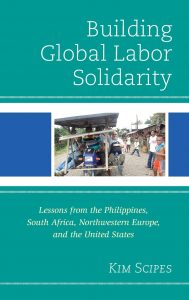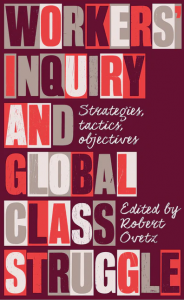Can Workers Overseas Provide Tips for U.S. Union Organizers?
 Building Global Labor Solidarity: Lessons from the Philippines, South Africa, Northwestern Europe and the United States, by Kim Scipes, (Lanham, MD: Lexington Books, 2021)
Building Global Labor Solidarity: Lessons from the Philippines, South Africa, Northwestern Europe and the United States, by Kim Scipes, (Lanham, MD: Lexington Books, 2021)
Workers’ Inquiry and Global Class Struggle: Strategies, Tactics, Objectives, edited by Robert Ovetz, (London: Pluto Press, 2020)
 The worldwide spread of Covid-19 created major challenges for workers and their unions throughout the globe. These very similar pandemic disruptions provided a timely reminder of the inter-connectedness of the global economy—and the need for cross-border union connections that enable workers to share information about their own struggles and learn from labor movements in other countries.
The worldwide spread of Covid-19 created major challenges for workers and their unions throughout the globe. These very similar pandemic disruptions provided a timely reminder of the inter-connectedness of the global economy—and the need for cross-border union connections that enable workers to share information about their own struggles and learn from labor movements in other countries.
What are some of the “best practices” abroad that might be reproducible in the U.S. to help boost union density and bargaining clout here? Two labor-oriented academics, Kim Scipes and Robert Ovetz, have recently published collections of case studies that answer that question in great detail. Their new books will be useful to both practitioners in the field and campus-based observers of comparative labor movements.
In Building Global Labor Solidarity, Scipes, a professor of sociology at Perdue, brings together the results of his own research, writing, and international labor activism over the last four decades. He is the author of two previous volumes on related topics—KMU:Building Genuine Trade Unionism in the Philippines, 1980-1994 (New Day Publishers, 1996) and AFL-CIO’s Secret War Against Developing Country Workers: Solidarity or Sabotage? (Lexington Books, 2010). He’s also involved in efforts to get delegates to the national AFL-CIO convention in Philadelphia this month to re-think the labor federation’s past and present approach to its not always helpful “international operations.”
Shop Floor Internationalism
With a focus on “social movement unionism” that overlaps with Ovetz’s, Scipes new book describes workplace organizing by South African and Filipino workers—and how it was supported by U.S. unions like the International Longshore and Warehouse Union (ILWU). As Scipes explains in his book, U.S. workers are far more likely to embrace what he calls “shop floor internationalism” if their own unions have an ILWU-like tradition of militancy and democracy. But many local and national labor organizations are not as rank-and-file oriented. And changing their leadership or structure—or building new unions to replace them– is not easy, at home or abroad. “While building global labor solidarity is a necessary task,” according to Scipes, “it is not sufficient: we must revitalize our domestic labor organizations.”
In Workers’ Inquiry and Global Class Struggle, Ovetz showcases the work of trade union researchers and organizers engaged in this project, in different ways, on four continents. They report on shop floor organizing and/or strike activity by truckers in Argentina, teachers in Mexico, tech workers in the U.K., auto makers in India, and other manufacturing workers in China and South Africa. Drawing on his own experience as a member of the California Faculty Association (CFA) at San Jose State University, Ovetz critiques past CFA contract campaigning in America’s largest public university system which, in his view, failed to produce a “credible statewide strike threat.” The result has been “modest wage gains cancelled out by concessions on productivity, two-tier medical coverage, and the growth of contingent lecturers.”
Other contributors to Workers’ Inquiry also try, in Ovetz’s words, to identify “new organizational forms, tactics, and strategies that can be deployed by workers to win, be it in their workplace, community, sector of the economy, or as a class.” In Mexico, public school teachers could not depend on their notoriously corrupt national union to defend them from neo-liberal “education reform.” So, in 1979, they created a grassroots network which expanded to 100,000 union activists around the country, particularly active in rural areas. This dissident caucus, known as CNTE, has maintained its political autonomy and continues to resist “privatization of a vital and highly lucrative public service,” even under the more labor friendly government of President Andres Manuel Lopez Obrador.
Under conditions of far greater repression, Chinese factory workers, as described by Hong Kong labor researcher Jenny Chan, have found ways to fight for better conditions with or without the support of the country’s only legal labor organization, the All-China Federation of Trade Unions (ACFTU). As reported by Marxist scholar Anna Curcio, highly exploited immigrant workers in Italy’s logistics sector—many of them female and non-white—have resisted harassment, discrimination, and sexual violence in warehouse jobs by using “their disruptive power” and forging alliances with “students and other precarious workers.” In post-apartheid South Africa, workers have used wild-cat strikes and sit-ins to confront former allies, like Cyril Ramaphosa. He led the South African miners’ union before becoming one of his country’s richest men and then a successful African National Congress candidate for president.
A Social Movement Union
In Building Global Labor Solidarity, Scipes returns to the subject of insurgent unionism in the Philippines. He recounts the history of the Kilusang Mayo Uno (KMU), a radical labor federation that developed during the dictatorship of Ferdinand Marcos (whose kleptocratic family just returned to power via the election of his son, Ferdinand, Jr. as president of the country). KMU was the product of militant union organizing in manufacturing plants, copper mines, sugar plantations, and other forms of agriculture. When founded forty years ago, the new labor center had only 50,000 members. But, as an alternative to traditional unions that sold out their members and failed to organize against foreign domination of the economy, KMU quickly expanded to include nearly 750,000 workers by the late 1980s-early 1990s.
By 1989, KMU had played a catalytic role in several nationwide general strikes, while surviving the arrest, detention, and, in some cases, murder of key militants. Its organizing model, according to Scipes, emphasized “rank-and-file member, not just steward level, education, building new relationships with sectoral organizations across the social order; and uniting with workers and labor organizations around the world.” In addition to putting thousands of workers through a 3-day popular education course on “Genuine Trade Unionism,” the KMU was a key part of BAYAN. This broader community-labor coalition included several million people involved in women’s rights campaigns, organizations of the urban poor, and opposition to U.S. military bases.
In the Philippines during this period, KMU activists not only experienced state-sanctioned violence under the original Marcos regime. They also had to compete with the AFL-CIO-backed Trade Union Congress of the Philippines (TUCP), which championed “Christian values” and fervent anti-communism. Created with government support during a period of martial law, the TUCP received millions of dollars from the U.S. labor federation’s Asian-American Free Labor Institute (AAFLI). This cold-war institution was far more concerned about reducing radical labor influence than challenging the exploitation of Filipino workers by multi-national companies.
As a leading U.S. backer of the KMU for four decades, Scipes has helped educate fellow trade unionists here about the negative role played by AFL-CIO operatives in the Philippines and other less developed countries—even as part of a rebranded Solidarity Center. As noted above, he’s part of a new pressure group, called the Labor Education Project on AFL-CIO International Operations (LEPAIO). One founding principle of LEPAIO is opposition to continuing “US government funding of the AFL-CIO or any US labor organization for international work.” Instead the group advocates for “direct worker to worker links” with union members throughout the world and solidarity actions that target the multi-national companies that have become their common adversaries. That’s a common sense approach, whose feasibility and effectiveness is well documented and explained in Building Global Labor Solidarity and in Workers’ Inquiry and Global Class Struggle.
Reviewed by Steve Early, a former International Union representative for the Communications Workers of America. For many years in CWA District One, he helped coordinate worker solidarity with labor activists in Colombia as part of a membership dues funded Union-to-Union solidarity program. He can be reached at Lsupport@aol.com.
